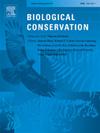International border fences and walls negatively affect wildlife: A review
IF 4.9
1区 环境科学与生态学
Q1 BIODIVERSITY CONSERVATION
引用次数: 0
Abstract
Since 2001 there has been a global increase in border barrier (fences, walls) construction, most often for border security and to dissuade human access. In this review we summarize effects of anthropogenic international border barriers on wildlife, identify whether issues of habitat fragmentation, gene flow, water access, climate change, and conservation were considered, and how animal size and mobility influenced response to these barriers. We conducted a literature review for studies describing effects of international border barriers on animals and categorized information about wildlife species, barriers and their effects. We found 42 peer-reviewed journal articles that represented studies from four continents (Africa, Asia, Europe, North America) or referenced barriers globally. All articles were published after 2006, indicating increased interest in wildlife in the context of border barriers. Barrier heights ranged from 1.5 to 8 m. Most studies focused on large mammals (≥25 kg) of high mobility. Habitat fragmentation and conservation issues were most frequently considered, with fewer discussing issues of gene flow, water as a limiting resource, or effects of climate change. Ten of 29 wildlife species had decreasing populations and were listed as at risk. Research on the ecological effects of these barriers on wildlife is thus inadequate for identifying threats given the current extensive border fortification globally, especially in the last decade. Barriers presented a negative effect for mobile species and contributed to the decline of animal populations, including those identified as threatened or endangered. Recommendations to prevent further degradation of habitat include cross-border collaboration, creation of peace parks, use of technologically advanced surveillance instead of physical barriers, placing fences in areas that would not disrupt wildlife migration routes, creating wildlife-friendly openings in fences, and wildlife-friendly fencing.
求助全文
约1分钟内获得全文
求助全文
来源期刊

Biological Conservation
环境科学-环境科学
CiteScore
10.20
自引率
3.40%
发文量
295
审稿时长
61 days
期刊介绍:
Biological Conservation is an international leading journal in the discipline of conservation biology. The journal publishes articles spanning a diverse range of fields that contribute to the biological, sociological, and economic dimensions of conservation and natural resource management. The primary aim of Biological Conservation is the publication of high-quality papers that advance the science and practice of conservation, or which demonstrate the application of conservation principles for natural resource management and policy. Therefore it will be of interest to a broad international readership.
 求助内容:
求助内容: 应助结果提醒方式:
应助结果提醒方式:


